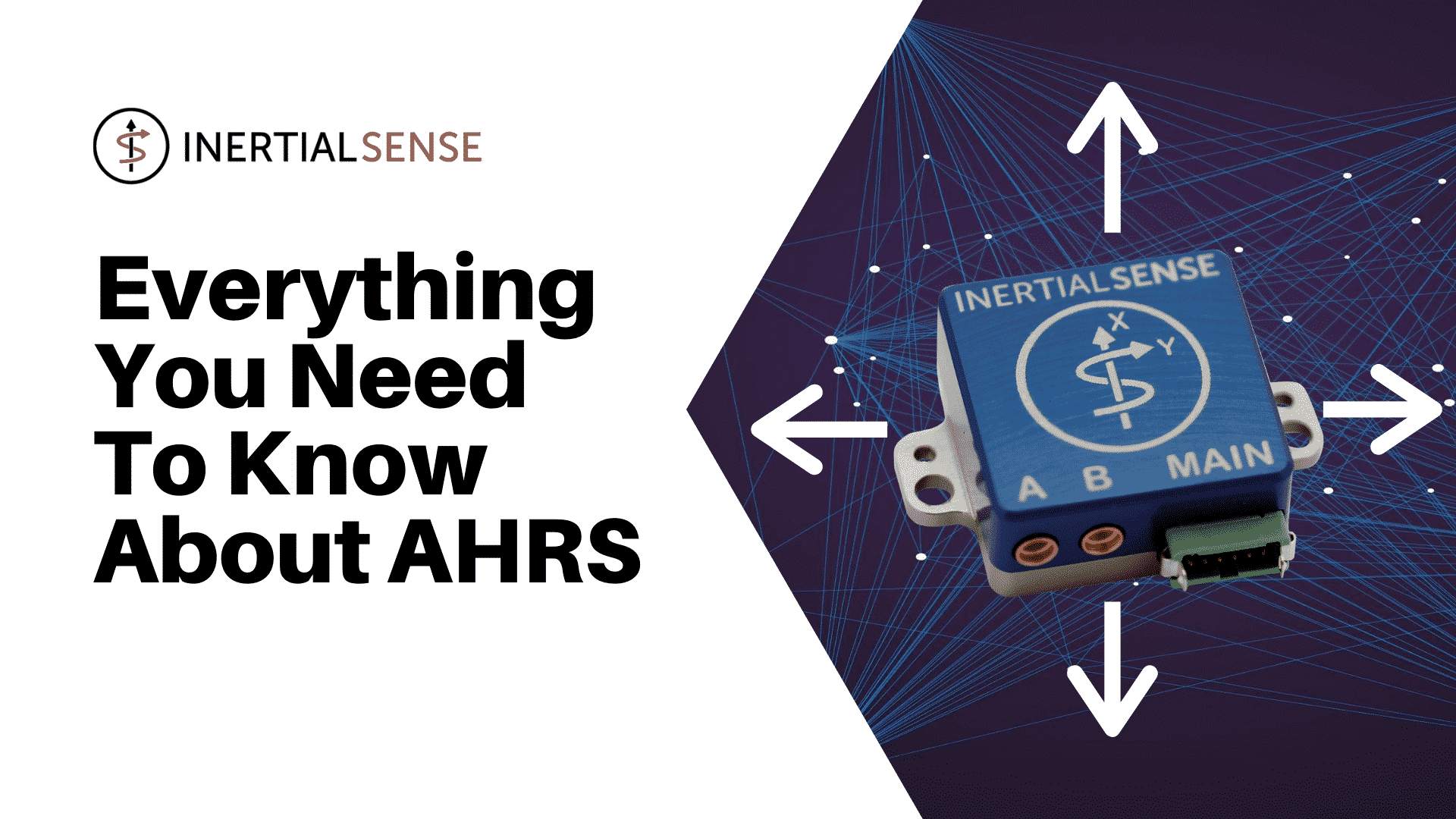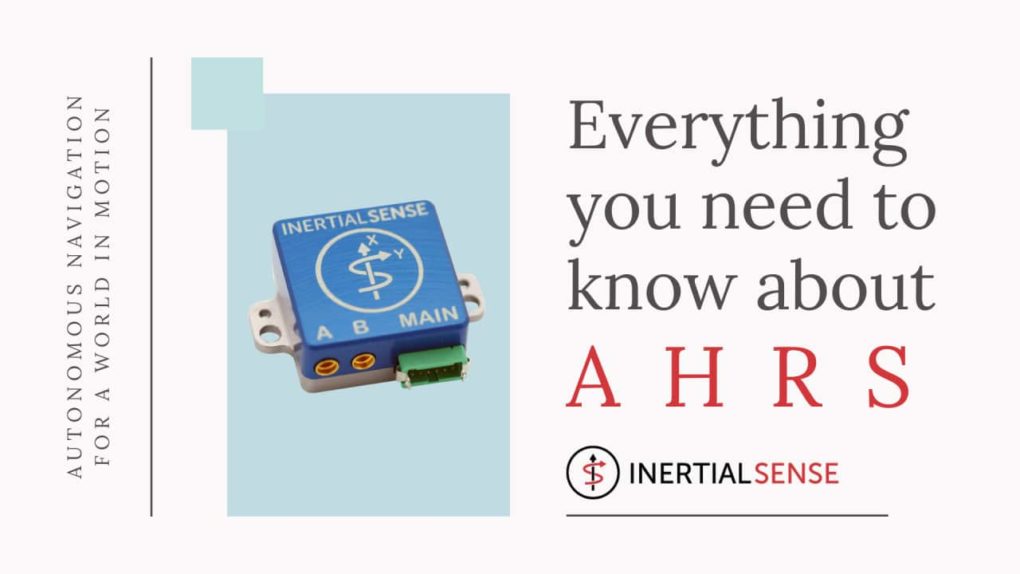
Everything You Need to Know About Attitude and Heading Reference Systems (AHRS)
Have you ever questioned how automated drones (like the Amazon drones we’ve all heard rumors about) decide where to fly, how fast to go, or even where they’re physically located within their legal airspace? If you answered “GPS” you’d be about 30% right… The answer you’re looking for is called Attitude and Heading Reference System, or AHRS for short.
AHRS is the same technology that informs pilots when to fly higher, drop-down, or even move the aircraft’s tail a bit to avoid unfavorable conditions. Before the idea of AHRS was conceived, aircraft would use mechanical gyroscopes, where the result was way off the mark. And when you are flying at 30,000ft or higher, ambiguity is your worst enemy.
This Attitude and Heading Reference System is comprised of a three-axis Inertial Measurement Unit that is connected to a virtual three-axis sensor and a 3-axis magnetic sensor for measuring the pitch, heading (yaw), and the roll angle while the object is moving in a 3D space. For being such a small system, the concept of AHRS powers some of the biggest technologies in our world today. Watch the video below as Carson Herbert explains how the Attitude and Heading Reference System works and which industries depend on it.
Basic Design of AHRS
AHRS is a combination of three separate equipment, that is a magnetometer/flux valve, a 3-axis Gyroscope, and three accelerometers. Each of them has their unambiguous functions.
- A magnetometer or flux valve is used to study the horizontal components of our magnetic field.
- The Gyroscope assists in measuring the device’s linear motion (roll, yaw, and pitch axis).
- The accelerometers are used for measuring the aircraft’s linear motion by studying its three-axis, that are longitudinal, lateral, and vertical axis.
The compact design of AHRS has helped the engineers to replace the six LRUs (Line Replaceable Unit) with a single unit. The compact design of AHRS drastically reduces the vehicle’s weight, footprint, power requirements, and wiring.
Apart from its compressed design, AHRS has several other advantages over the conventional vertical gyro.
- In the conventional equipment, when the aircraft’s roll angle would exceed a certain limit of 5-10 degrees, the automatic vertical erection would phase out. It will start free-drifting and produce a vertical error.
Whereas, in AHRS, a velocity damped Schuler-tuned vertical erection loop is used. The velocity damped Schuler-tuned vertical erection loop is an advanced military-grade equipment system that doesn’t need any small vertical cutoff angle. It can maintain stable continuity in its true local vertical.
- Under certain conditions, conventional gyros are prone to gimbal lock. Due to the absence of acceleration and rate feedback terms, gimbal lock is the most well-known issue of conventional gyros.
Whereas, in AHRS, there is no such annoyance as it measures the earth-based aircraft’s body axis and supplies the data to the automatic flight control system in separate coordinate reference frames.
Essential Components of The AHRS Box
The major component of AHRS is the AHRU (attitude heading reference unit). AHRU is a box that contains the essential rate gyros, accelerometers, power supplies, and other tools that are used for measuring the acceleration forces, rate of change, aircraft’s attitude, and the magnetic heading.
There are two types of AHRU, that is analog and digital. Both are being used in different industries based on their requirement.
To improve the efficiency of the AHRS, it is sometimes combined with an air data sensor for improving weight, wiring, and space requirements.
What’s the difference between AHRS and IMU? The main difference between an IMU (inertial measurement unit and an AHRS is the fact that AHRS includes an on-board processing system that is specifically designed to track attitude and heading information. AHRS has a superior build quality that cuts out the middleman that IMU relies on. Where AHRS has a dedicated onboard system for attitude and heading data, IMU simply delivers sensor data to an additional device that computes attitude and heading.
Industries That Are Dependent On AHRS
Some of the top industries that utilize AHRS technology include:
- Manufacturing Robotics
- Agricultural Surveying
- Aquatic Navigation
- Drone Localization and many more.
AHRS is used in several ways across all industries. The top three most popular ways AHRS can be utilized include:
- As a recording instrument (think flight data) by using it as an orientation of the platform as a function of time.
- It can be used to create and maintain platform stabilization by directly tying the angular rate outputs with the control loop.
- As an attitude control system
With the advancement of technology, AHRS’s price has dropped down to a significant level within a few years. Earlier, AHRS was only used in military equipment and public aircraft.
Helicopters, aircraft, blimps, quad-rotors, as well as robotic vehicles, can create a closed-loop attitude control system using AHRS.
The size of the AHRS is dependent on its usage and manufacturer. These days, you can find AHRS that is the size of a coin. Here at Inertial Sense, our AHRS provides optimal estimation by fusing the MEMs gyros, accelerometers, magnetometers, and barometric pressure while also including all of the IMU functionality.
If you’d like to learn more about the smallest and lightest inertial Attitude Heading Reference System on the market please contact us today!

Video Transcript
Welcome to my first video. My name’s Carson Herbert, and I am a sales engineer for Inertial Sense, Incorporated. I have chosen to discuss a little bit with you today about our μAHRS module. μAHRS stands for Attitude Heading Reference System, and it is one of four different sensor packages that Inertial Sense offers. In order to fully understand the μAHRS, you need to understand the sensors that are built around it. We have several levels. We have the IMU, we have the μAHRS, we have the INS+RTK, and we have a dual antenna or dual compassing INS.
Basically, how these sensors work is you have just like, for example, how the earth is laid out. The earth has a core and then it has several layers built up on top of it, all right? And from those layers, we get the full earth. All right? These sensors are very similar to that. The IMU, basically acts as the core of our sensor packages. And then we build up around that IMU to create a full dual-compassing INS solution.
Each one of these modules is differently priced just because of the engineering that has had to go into the module itself. First thing we want to discuss is before you can really understand how an μAHRS works, Attitude Heading Reference System, you need to understand the IMU because the IMU is the core to the μAHRS.
So the IMU is basically a sensor with many other little sensors inside of it. It’s got a barometer, it’s got a magnetometer, it’s got gyros in it, it’s got an accelerometer. So it has several different sensors inside it. And what the data that you get from an IMU is just the raw data. So basically if you’re using our firmware and you have an IMU, the only data that you’re going to receive from this IMU is going to be the raw data from each one of those sensors. Once you understand that, that the IMU only outputs raw data, then you can kind of understand what an μAHRS does because an Attitude Heading Reference System takes those IMU sensors, fuses them together, and then adds the algorithms with respect to the earth’s gravity. In simple terms, that basically means we’ve put in the mathematics and the algorithms inside the filter. The filter is inside of this little sensor package as well. Filters are all in there, and what it does is it tells the sensor which way is up and which way is down. That gives you attitude data. It gives you the role, it gives you the pitch, and it gives you the heading, it gives you the attitude.
Some quick facts about our μAHRS, very important facts that most of the time get people the information they need is that you will get 0.1 degrees roll and pitch of this. So you’ll be able to measure the tilt up to 0.1 degrees. It’s going to have a two degree magnetic heading from the magnetometer. And it’s going to have a 500 hertz output rate, meaning that it’s going to stream the data to your device at 500 hertz.
This μAHRS module currently has a GPS inside of it. So that GPS is basically simply utilized for simple timestamping purposes. A lot of people use our μAHRS module in cameras and such, and they need timestamps. This is not a fully configured GPS solution. If you need a fully configured GPS solution, you’ll have to go a step up to the INS because the INS contains that. The μAHRS, on the other hand, only has GPS that is configured for simple timestamping purposes.
Some of the applications for this include drones. We have a fascinating use case in Peru right now. We have a team of robotics engineers that are working on sending a drone down into a mine shaft, and because a mine shaft is a GPS-denied environment, they will be outputting the roll and pitch of their drone off of the sensor data here. I don’t know how far they’ve gone with it, but it’s one of the more fascinating use cases.
We’ve also had robotic arms. This μAHRS has been put on top of helmets, motorcycle helmets, insurance companies have decided to take that route using an μAHRS module. It tells them the roll and pitch of their helmet, if there’s an accident. In addition, it can timestamp so it can kind of tell them how fast that person is going.
And, ground robotics is another big one. Those are the basics of the μAHRS sensor. UAVs. It can be used in UAVs. The only drawback of the μAHRS, compared to the INS, is that the INS has the fully configured GPS.
That being said, if you have any other questions about our μAHRS module, feel free to reach out to me. Google Inertial Sense. It’ll have my phone number there in the sales line and Carson.Herbert@inertialsense.com, if you prefer to send me an email, but I’m here to answer any questions that you have. I’ll do some future videos on the INS so you understand the differences between the μAHRS and the INS, and we’ll go for it from there. Let me know if you have any questions. Take care.

